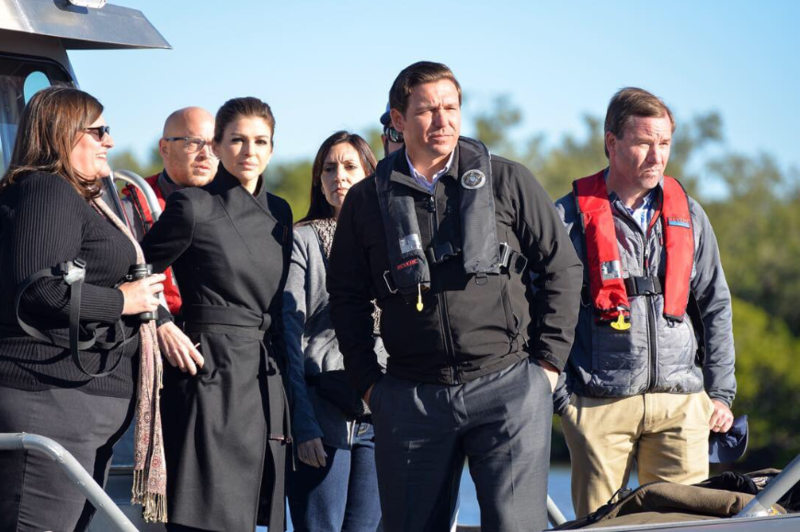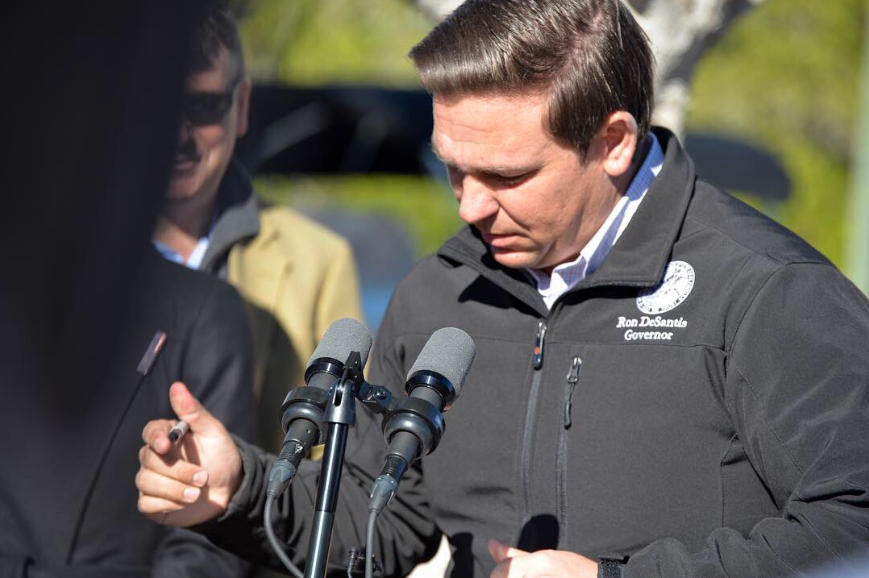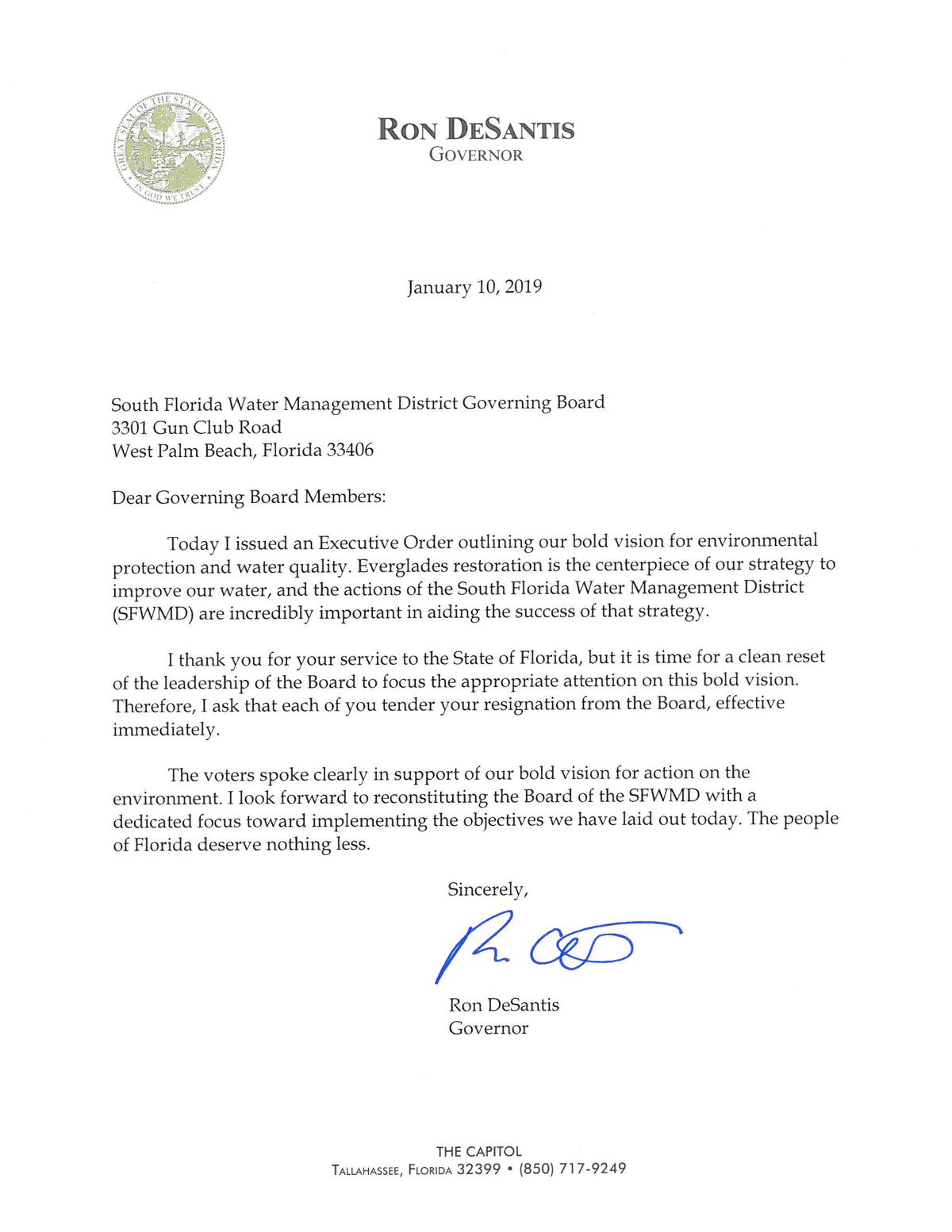Gov. DeSantis Pledges $2.5 Billion for Environment, Asks SFWMD Board to Resign
Governor Ron DeSantis spent the day touring the state announcing big changes to the way his office will handle water issues. He started by signing an executive order to dramatically increase funding for the Everglades, algae research, and a ban on hydraulic fracking. He ended the day in Stuart, Florida announcing he had asked for the resignation of every board member at the South Florida Water Management District.
The morning began with a quick boat tour of the Little Hickory Bay behind Bonita Beach, where Governor Ron DeSantis stood, flanked by conservation leaders, a fishing boat captain, and state legislators. After docking, he signed an executive order to spend 2.5 billion dollars on work and research to solve water flow problems, algae blooms, and other environmental concerns.
“That represents one billion dollars more than the previous four years,” DeSantis said.
His order also calls for the appointment of a “Chief Science Officer” and moving enforcement of environmental law under the jurisdiction of the Department of Environmental Protection- as opposed to the Fish and Wildlife Conservation Commission; which oversees enforcement now. Two moves that stood out to Conservancy of Southwest Florida President Rob Moher.
“I think the enforcement and the focus on science have been critical missing pieces and that’s a big missing piece that we have not had on the table that is now on the table,” Moher said.
The executive order also establishes a “Blue-Green Algae Task Force,” creates an “Office of Environmental Accountability and Transparency,” and urges the South Florida Water Management District to immediately push forward with the Everglades Agricultural Area Reservoir.
The Governor also expressed frustration with the Army Corps of Engineers, and his executive order includes language holding that agency to account.
“We want them to understand the effects that the blue-green algae has had on the coastal communities and to do everything in their power – which I don’t think they’ve done so far- to mitigate that,” DeSantis said.
Later in the day at a stop in Stuart, DeSantis announced he’d sent a letter to every member of the South Florida Water Management District board thanking them for their service, and asking for their resignation – effective immediately.
This is the same board that, just before the election late last year, approved to lease 16,000 acres – which was to be used in the EAA Reservoir Project – for farming by New Hope Sugar Company through 2027.
From: Governor's Press Office
Sent: Thursday, January 10, 2019 9:57 AM
Subject: Governor Ron DeSantis Announces Major Water Policy Reforms
Sent: Thursday, January 10, 2019 9:57 AM
Subject: Governor Ron DeSantis Announces Major Water Policy Reforms
Contact: Dave Vasquez (727) 504-4676 |
Governor Ron DeSantis Announces Major Water Policy Reforms
Tallahassee, Fla. – Today, Governor Ron DeSantis signed Executive Order 19-12 (Achieving More Now For Florida’s Environment), implementing major reforms to ensure the protection of Florida's environment and water quality.
"Our water and natural resources are the foundation of our economy and our way of life in Florida," said Governor Ron DeSantis. "The protection of water resources is one of the most pressing issues facing our state. That’s why today I'm taking immediate action to combat the threats which have devastated our local economies and threatened the health of our communities."
The order calls for:
- $2.5 Billion over the next four years for Everglades restoration and protection of water resources (a $1 Billion increase in spending over the previous four years and the highest level of funding for restoration in Florida’s history).
- The Establishment of a Blue-Green Algae Task Force, charged with focusing on expediting progress toward reducing the adverse impacts of blue-green algae blooms now and over the next five years.
- Instruction to the South Florida Water Management District to immediately start the next phase of the Everglades Agricultural Area Storage Reservoir Project design and ensure the U.S. Army Corps of Engineers approves the project according to schedule.
- The Creation of the Office of Environmental Accountability and Transparency charged with organizing and directing integrated scientific research and analysis to ensure that all agency actions are aligned with key environmental priorities.
- The Appointment of a Chief Science Officer to coordinate and prioritize scientific data, research, monitoring and analysis needs to ensure alignment with current and emerging environmental concerns most pressing to Floridians.
Executive Order 19-12: Achieving More Now For Florida’s Environment
Section 1: Focus on Rapid Improvement for Water Quality, Quantity and Supply
I hereby direct the Department of Environmental Protection (DEP), the Department of Health (DOH) as provided in paragraph J below, and Visit Florida and the Department of Economic Opportunity (DEO) as provided in paragraph L below, to take the following actions to enhance Florida’s water quality and preserve its natural resources:
A. Secure $2.5 billion over the next four years to invest in Everglades restoration and protecting our water resources.
B. Establish a Blue-Green Algae Task Force, charged with focusing on expediting progress toward reducing the adverse impacts of blue-green algae blooms now and over the next five years. This task force should support key funding and restoration initiatives to expedite nutrient reductions in Lake Okeechobee and the downstream estuaries. This task force should identify priority projects for funding that are based on scientific-data and build upon Basin Management Action Plans to provide the largest and most meaningful nutrient reductions in key waterbodies, as well as make recommendations for regulatory changes.
C. Update and secure all restoration plans, within one year, for waterbodies impacting South Florida communities, including Lake Okeechobee and the Caloosahatchee and St. Lucie Estuaries. These updates will ensure that the Blue-Green Algae Task Force has the necessary information to provide guidance to DEP on maximizing the investments in water quality improvements.
D. Instruct the South Florida Water Management District to immediately start the next phase of the Everglades Agricultural Area Storage Reservoir Project design and ensure the U.S. Army Corps of Engineers approves the project according to schedule.
E. Expedite key Everglades projects including the C-44 reservoir and stormwater treatment area, C-43 reservoir, Tamiami Trail and additional projects necessary to protect our waterways and natural resources.
F. Work with the South Florida Water Management District to add stormwater treatment to the C-43 Reservoir to provide additional treatment and improve the quality of water leaving this important storage component.
G. Expedite projects with the U.S. Army Corps of Engineers to improve management of Lake Okeechobee, including updating the Lake Okeechobee Regulation Schedule and identifying water quality treatment technologies to install near water control structures in Lake Okeechobee.
H. Direct DEP to establish a septic conversion and remediation grant program with a local government match requirement.
I. Instruct all five water management districts to increase transparency and accountability by providing data and information to DEP to support key water quality restoration efforts. Instruct all water management districts to review budgets and prioritize available funding to focus on projects that will help address harmful algae blooms and maximize nutrient reductions.
J. Participate in Florida Fish and Wildlife Conservation Commission’s (FWC) Harmful Algal Bloom Task Force to provide technical expertise and assistance studying causes and impacts of red tide. The DOH is also directed to participate in FWC’s Task Force to help study air quality and human health impacts of red tide.
K. Continue DEP’s red tide emergency grant program to support local governments to clean up their beaches and coastal areas to minimize the impacts of red tide to residents and visitors.
L. Partner with Visit Florida and DEO to identify opportunities within communities and recommend investments in green infrastructure, such as wetland treatment systems, that benefit our natural resources and local economies by increasing recreational and tourism opportunities, while improving water quality.
M. Engage local governments, industry, universities and water management districts to identify and research all viable alternative water supply sources and provide an assessment of funding needs critical to supporting Florida’s growing economy. DEP should take all necessary steps to establish recurring funding for an alternative water supply grant program to help communities plan for and implement vital conservation, reuse and other alternative water supply projects.
N. Engage local governments, industry, citizens and other stakeholders through a targeted education and outreach campaign that will focus on the importance of conservation and reuse efforts and encourage Floridians to implement essential conservation and reuse efforts in their homes, businesses and communities throughout Florida.
O. Continue to explore every option to stop Georgia’s harmful upstream water use from causing further adverse impacts to the Apalachicola River and Bay.
Section 2: Restructuring to Focus on Accountability, Transparency, and Science to Achieve More Now for Florida’s Environment
I hereby direct DEP to implement the following actions to ensure the agency is making sound decisions based on the best available science and providing for accountability and transparency:
A. Create the Office of Environmental Accountability and Transparency charged with organizing and directing integrated scientific research and analysis to ensure that all agency actions are aligned with key environmental priorities.
B. Appoint a Chief Science Officer to coordinate and prioritize scientific data, research, monitoring and analysis needs to ensure alignment with current and emerging environmental concerns most pressing to Floridians.
C. Take all necessary actions to move the Environmental Crimes Enforcement Unit from FWC to DEP to align resources focused on environmental protection and ensure strong enforcement of Florida’s environmental laws.
Section 3: Ensure Florida’s Valuable and Vulnerable Coastlines and Natural Resources are Protected
I hereby direct DEP to implement the following actions to protect Florida’s coastlines and natural resources:
A. Create the Office of Resilience and Coastal Protection to help prepare Florida’s coastal communities and habitats for impacts from sea level rise by providing funding, technical assistance and coordination among state, regional and local entities.
B. Take necessary actions to adamantly oppose all off-shore oil and gas activities off every coast in Florida and hydraulic fracturing in Florida.



No comments:
Post a Comment